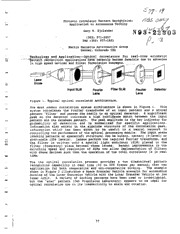
NASA Technical Reports Server (NTRS) 19930013114: Photonic correlator pattern recognition: Application to autonomous docking PDF
Preview NASA Technical Reports Server (NTRS) 19930013114: Photonic correlator pattern recognition: Application to autonomous docking
"77 Photonic Correlator Pattern Recognition: /_' _/J/_7 c / Application to Autonomous Docking Gary W. Sjolander N93- 3 (303) 971-3257 FAX (303) 977-1921 Martin Marietta Astronautics Group Denver, Colorado USA ;_kii-_echnology and Appllcation--Optical correlators for real-time automatic _:_aq_r_gnition appiicatlonsh-av-e recently become feasible due to advances =in high speed devices and filter formulation concepts. w Diode w Input SLM Fourler Fllter SLM Fourler Detector _ r Lens Lens w Figure i. Typical optical correlator architecture. ± L T : _ T T The most common correlation system architecture is shown in Figure I. This system correlates the Fourier transforms of an input pattern and a stored pattern 'filter' and passes the result to an optical detector. A significant peak on the detector indicates a high confidence match between the input pattern and the database pattern. The peak amplitude is the key indicator for w probability of detection and is normalized for specific applications. Information also exists in the sidelobe structure of the correlation peak, - L information which has been shown to be useful to a neural network in controlling the performance of the optical processing module. The input scene (docking patterns or spacecraft structure) can be binary, ternary (3-1evel) or gray-scale (256 levels). Lenses perform the required Fourier transforms, and the filter is written onto a spatial light modulator (SLM) placed in the filter (frequency) plane between these lenses. Recent improvements in the switching speed and resolution of SLMs now allow implementation of filters with these devices such that the operation of the total correlator is in real time. m The the optical correlation process provides a two dimensional pattern recognition capability in real time (30 to 500 frames per second) that has application for both cooperative and non-cooperative docking. The example shown in Figure 2 illustrates a Space Transfer Vehicle scenario for autonomous docking of the Lunar Excursion Vehicle with the Lunar Transfer Vehicle at low lunar orbit. A variety of docking patterns have been used or investigated, but the "star" pattern (Jet Propulsion Laboratory) appears to be ideal for optical correlation due to its insensitivity to scale and rotation. m w L- 77 m Autonomous Docking: Optical Correlator m m = lm [] i m Dlodo ElM ELM [] ._iaUon Attltudo Error Outpl Dotootor | m mm Figure 2. Optical correlator assisted docking. !R History 0f Martin Mar_ietta Photonlc systems--Since 1988, The Martin Marietta Corporation has committed to the development and implementation of advanced optical correlators (photonic correlatora) baaed processing systems l that willmeet the demands o_ future high data throughput. To meet this i objective, the corporation has assembled a team of recognized experts to develop advanced pattern recognition technology. This team is comprised of ! industrial-and university Scientists and engineerswho _re deveioping optical i correlation technology, neural networks, hardware components, and related image processing techniques. Team members include the University of Colorado Optoelectronic Computing Systems Center and the University of Dayton Research Institute.--_hotonic Systems_is_ading the state-of_the-art in pattern recognition technology that uses coherent optical processing. D Maturity--The Photonics team is currently performing a Government contracted effort to build, evaluate, and flight test a ruggedized optical processing m module for pattern recognition. In addition, we are building four compact optical systems for mobile platforms and three new systems for table-top use. These systems perform pattern recognition on diverse applications ranging from military target recognition to signal processing to human chromosome Im identification. The Photonics Systems Center was established to transfer this z P 77-I m m highly promising pattern recognition technology into systems applications. This Center possesses every state-of-the-art electro-optical component for w advanced image processing and over 300 software programs dedicated to simulation of potential application of optical processing to pattern recognition. In the near future, our photonics technology will be combined with system level simulation capability utilizing our robotics laboratory and the Space Operation Simulation Laboratory. The need for optical correlators that are used outside the laboratory has w stimulated many advances in optical correlator architectures. The first major advance was the use of a telephoto lens system to shorten the correlator optical path from 4 meters to i meter. This resulted in practical implementation of the optical correlators to realistic table-top applications. w m w i Figure 3. Martin Marietta programmable portable correlator. During 1990, we developed the first portable programmable correlator, which has a length of 11.5 inches from the input SLM to the detector plane and is shown in Figure 3. This portable correlator uses magneto-optic spatial light modulators (MOSLMs) and is capable of operating on binary or ternary input images at a 500 frame per second filter rate. In 1991, Martin Marietta developed a new compact correlator that uses ferro- electric liquid crystal (FLC) spatial light modulators capable of frame rates in excess of 1,000 Hz. This breadboard unit has been further refined and a prototype unit is being assembled. The FLC SLMs being used are reflective and electrically addressed. The projected capability for FLC SLMs is for 512x512 pixel frames operating at 10,000 frames per second by the end of 1992. w Source/sponsorshlp--The initial source of funding for photonics technology was provided by IR&D and corporate monies. This investment resulted in a DARPA contracted activity just under $3M over a period of 32 months that is part of their Transfer of Optical Processing to Systems (TOPS) program. w 77-II w 1
